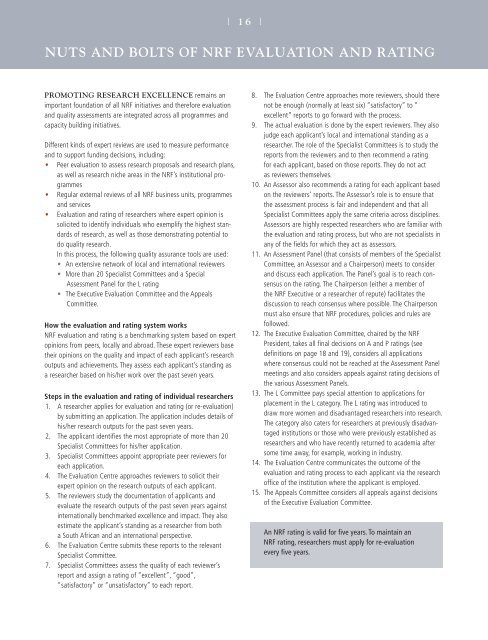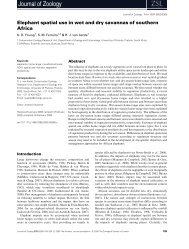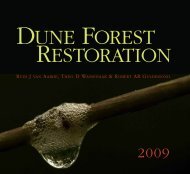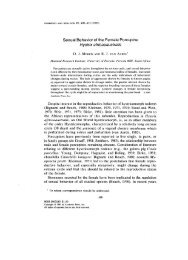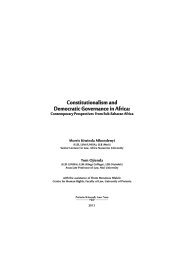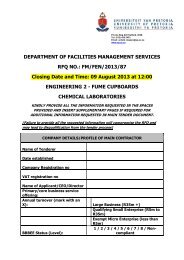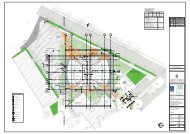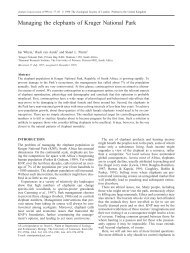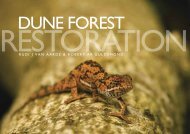Evaluation and Rating Facts & Figures - 2007 - National Research ...
Evaluation and Rating Facts & Figures - 2007 - National Research ...
Evaluation and Rating Facts & Figures - 2007 - National Research ...
You also want an ePaper? Increase the reach of your titles
YUMPU automatically turns print PDFs into web optimized ePapers that Google loves.
| 1 6 |<br />
NUTS AND BOLTS OF NRF EVALUATION AND RATING<br />
PROMOTING RESEARCH EXCELLENCE remains an<br />
important foundation of all NRF initiatives <strong>and</strong> therefore evaluation<br />
<strong>and</strong> quality assessments are integrated across all programmes <strong>and</strong><br />
capacity building initiatives.<br />
Different kinds of expert reviews are used to measure performance<br />
<strong>and</strong> to support funding decisions, including:<br />
• Peer evaluation to assess research proposals <strong>and</strong> research plans,<br />
as well as research niche areas in the NRF’s institutional programmes<br />
• Regular external reviews of all NRF business units, programmes<br />
<strong>and</strong> services<br />
• <strong>Evaluation</strong> <strong>and</strong> rating of researchers where expert opinion is<br />
solicited to identify individuals who exemplify the highest st<strong>and</strong>ards<br />
of research, as well as those demonstrating potential to<br />
do quality research.<br />
In this process, the following quality assurance tools are used:<br />
• An extensive network of local <strong>and</strong> international reviewers<br />
• More than 20 Specialist Committees <strong>and</strong> a Special<br />
Assessment Panel for the L rating<br />
• The Executive <strong>Evaluation</strong> Committee <strong>and</strong> the Appeals<br />
Committee.<br />
How the evaluation <strong>and</strong> rating system works<br />
NRF evaluation <strong>and</strong> rating is a benchmarking system based on expert<br />
opinions from peers, locally <strong>and</strong> abroad. These expert reviewers base<br />
their opinions on the quality <strong>and</strong> impact of each applicant’s research<br />
outputs <strong>and</strong> achievements. They assess each applicant’s st<strong>and</strong>ing as<br />
a researcher based on his/her work over the past seven years.<br />
Steps in the evaluation <strong>and</strong> rating of individual researchers<br />
1. A researcher applies for evaluation <strong>and</strong> rating (or re-evaluation)<br />
by submitting an application. The application includes details of<br />
his/her research outputs for the past seven years.<br />
2. The applicant identifies the most appropriate of more than 20<br />
Specialist Committees for his/her application.<br />
3. Specialist Committees appoint appropriate peer reviewers for<br />
each application.<br />
4. The <strong>Evaluation</strong> Centre approaches reviewers to solicit their<br />
expert opinion on the research outputs of each applicant.<br />
5. The reviewers study the documentation of applicants <strong>and</strong><br />
evaluate the research outputs of the past seven years against<br />
internationally benchmarked excellence <strong>and</strong> impact. They also<br />
estimate the applicant’s st<strong>and</strong>ing as a researcher from both<br />
a South African <strong>and</strong> an international perspective.<br />
6. The <strong>Evaluation</strong> Centre submits these reports to the relevant<br />
Specialist Committee.<br />
7. Specialist Committees assess the quality of each reviewer’s<br />
report <strong>and</strong> assign a rating of “excellent”, “good”,<br />
“satisfactory” or “unsatisfactory” to each report.<br />
8. The <strong>Evaluation</strong> Centre approaches more reviewers, should there<br />
not be enough (normally at least six) “satisfactory” to “<br />
excellent” reports to go forward with the process.<br />
9. The actual evaluation is done by the expert reviewers. They also<br />
judge each applicant’s local <strong>and</strong> international st<strong>and</strong>ing as a<br />
researcher. The role of the Specialist Committees is to study the<br />
reports from the reviewers <strong>and</strong> to then recommend a rating<br />
for each applicant, based on those reports. They do not act<br />
as reviewers themselves.<br />
10. An Assessor also recommends a rating for each applicant based<br />
on the reviewers’ reports. The Assessor’s role is to ensure that<br />
the assessment process is fair <strong>and</strong> independent <strong>and</strong> that all<br />
Specialist Committees apply the same criteria across disciplines.<br />
Assessors are highly respected researchers who are familiar with<br />
the evaluation <strong>and</strong> rating process, but who are not specialists in<br />
any of the fields for which they act as assessors.<br />
11. An Assessment Panel (that consists of members of the Specialist<br />
Committee, an Assessor <strong>and</strong> a Chairperson) meets to consider<br />
<strong>and</strong> discuss each application. The Panel’s goal is to reach consensus<br />
on the rating. The Chairperson (either a member of<br />
the NRF Executive or a researcher of repute) facilitates the<br />
discussion to reach consensus where possible. The Chairperson<br />
must also ensure that NRF procedures, policies <strong>and</strong> rules are<br />
followed.<br />
12. The Executive <strong>Evaluation</strong> Committee, chaired by the NRF<br />
President, takes all final decisions on A <strong>and</strong> P ratings (see<br />
definitions on page 18 <strong>and</strong> 19), considers all applications<br />
where consensus could not be reached at the Assessment Panel<br />
meetings <strong>and</strong> also considers appeals against rating decisions of<br />
the various Assessment Panels.<br />
13. The L Committee pays special attention to applications for<br />
placement in the L category. The L rating was introduced to<br />
draw more women <strong>and</strong> disadvantaged researchers into research.<br />
The category also caters for researchers at previously disadvantaged<br />
institutions or those who were previously established as<br />
researchers <strong>and</strong> who have recently returned to academia after<br />
some time away, for example, working in industry.<br />
14. The <strong>Evaluation</strong> Centre communicates the outcome of the<br />
evaluation <strong>and</strong> rating process to each applicant via the research<br />
office of the institution where the applicant is employed.<br />
15. The Appeals Committee considers all appeals against decisions<br />
of the Executive <strong>Evaluation</strong> Committee.<br />
An NRF rating is valid for five years. To maintain an<br />
NRF rating, researchers must apply for re-evaluation<br />
every five years.


